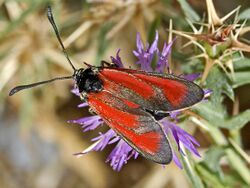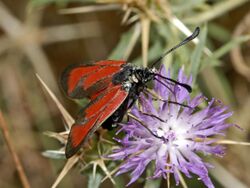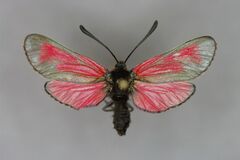Biology:Zygaena erythrus
| Zygaena erythrus | |
|---|---|

| |
| Zygaena erythrus, dorsal view | |

| |
| Lateral view | |
| Scientific classification | |
| Domain: | Eukaryota |
| Kingdom: | Animalia |
| Phylum: | Arthropoda |
| Class: | Insecta |
| Order: | Lepidoptera |
| Family: | Zygaenidae |
| Genus: | Zygaena |
| Species: | Z. erythrus
|
| Binomial name | |
| Zygaena erythrus (Hubner, 1806)
| |
Zygaena erythrus, common name sluggish burnet, is a species of moth in the family Zygaenidae.
Subspecies
- Zygaena erythrus erythrus
- Zygaena erythrus actae Burgeff, 1926
- Zygaena erythrus miserrima Verity, 1922
- Zygaena erythrus saportae Boisduval, 1829
Distribution and habitat
This endangered species can be found only in France and Italy.[1][2] It prefers dry and rocky areas with sparse vegetation and limestone substrate, but it is also present in heathlands, in nutrient-poor grasslands and in broad verges in oak forests with the host plant Eryngium species, from sea level to over 1,500 metres (4,900 ft).[1][3]
Description
Zygaena erythrus has a wingspan of 25–33 mm.[4] These quite large moths show enlarged and confluent red spots on the forewings, surrounded by black in the distal part. Females are little bigger than males, with a yellow golden dusting and less defined markings. The mature larva is rather dark greyish, with two series of dorsal black spots.[5]
This species is very similar to Zygaena purpuralis, but it has red scales in the axillary area of the forewings, up to a third of the length.[3]
Technical description and variation (Seitz)
Z. erythrus Hbn. (= saportae Boisd.; minos Boisd.) (4a). Larger; antenna longer, with thicker club. The red colour of forewing restncted to 3 streaks , the distal one being wedge-shaped ; moreover, only the basal third of the hindmargin of forewing is red. South France, Italy and Sicily. In ab. irpina Zickert, from the Riviera, the cuneiform spots are confluent. — As magna [Seitz, [1907] ] (4 a) a very large form from the Abruzzi is sold by Staudinger; the posterior cuneiform spot is strongly widened and distally straight-truncate.— Larva dull greenish yellow, witli heavy black dots subdorsally and yellow side-spots (Sapokta); in some districts not distinguishable from the larva of purpuralis. On Eryngium and Thyme (Rouast). Hibernating; pupation at end of May. Imago in June and July; frequently sitting on Thyme and Eryngium.[6]
Biology
The life cycle involves only one generation per year.[5] Adults are on wing from the end of June to the beginning or mid August.[7] The hatching occurs between June and July.[5] The larvae feed on Eryngium species,[8] including Eryngium campestre[1] and Eryngium maritimum.[9] Full-grown larvae can be found from June. Pupation occurs within a cocoon usually adherent to the lower surface of the leaves,[5] but also on the ground between lichens, moss and parts of plants.[7]
References
- ↑ 1.0 1.1 1.2 1.3 Zygaena at funet
- ↑ and Slovenia Fauna Europaea
- ↑ 3.0 3.1 Natura Mediterraneo
- ↑ Nature of Italy
- ↑ 5.0 5.1 5.2 5.3 Treknature
- ↑ Seitz, A., 1913, in Seitz, Gross-Schmett. Erde 6: 22.,The Macrolepidoptera of the Palearctic Fauna 2. Volume: The Palearctic Bombyces & Sphinges. pdf
- ↑ 7.0 7.1 Schmetterlinge und ihre Ökologie
- ↑ Moths and Butterflies of Europe and North Africa
- ↑ lepiforum.de
Wikidata ☰ Q8075762 entry
 |


